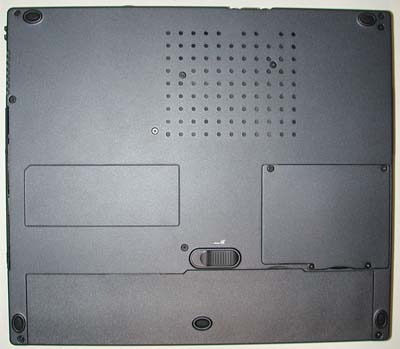Intel Centrino/Pentium-M Notebook Roundup: Dell, FIC and IBM Examined
by Matthew Witheiler on March 12, 2003 11:22 AM EST- Posted in
- Laptops
FIC Centrino - Build, Appearance, Size (continued)
With the speakers located below the LCD panel, the front of the FIC Centrino notebook is bare. The only item here is the screen release lever which is slid to the right to open the unit.
The left side of the system is also very bare but elegant at the same time. The first half of the left side contains no ports or jack. Halfway back starts the single PCMCIA type-II slot. Although size on the FIC notebook is at a larger premium than on the Dell Latitude D800, we still would have liked to see two PCMCIA slots on the system for future upgrades. It looks like there may be room on the system (and the IBM units prove that there is room). The left side of the system is topped off with a 4-pin unpowered mini IEEE-1394 firewire port and two audio jacks, one for headphones out and one for microphone in.
The jacks on the back of the system are actually mislabeled on the case (remember we are dealing with an early engineering sample here). Contrary to what the case may indicate, the first jack on the back of the notebook is a modem jack. The second jack is the ethernet jack. Next to these jack are a set of three USB 2.0 ports mounted horizontally side by side followed by a VGA-out jack. There is a small cooling vent next and the system's power in port. Finally the large vent in the back is an exhaust for the CPU fan.
The right side of the system features the lock port, a cool air intake for the CPU fan, and the system's optical drive. In our unit the optical drive bay was outfitted with a combination CD-RW/DVD drive.
There is one access panel on the bottom of the FIC Centrino notebook. This panel gives access to the system's hard drive. The battery can also be removed by sliding the release lever to the left and lifting the battery up and out of the unit.
The FIC Centrino solution is a good deal smaller than the Dell Latitude D800. The system measures 12.2" x 10.75" x 1.0" and seems to weigh around 6 pounds (we cannot be sure since we do not have exact specifications of the unit yet). The size of the unit qualifies it as a thin and light notebook. The system proved very easy to carry around and comfortable to work with. FIC did a wonderful job in this area.














3 Comments
View All Comments
builda - Thursday, February 2, 2006 - link
There appears to be a wide spread fault with the Gigabyte NB-1401 model notebook, where it reports having system disk errors or cannot find the hard disk. We have 7 of this model notebook and now 6 of them have reported the same problem. After running chkdsk to temporarily repair the errors that had been caused on the harddisk I found the problem returned the escalated to the point the harddisk could not be found. I further checked using Hitachi drive fitness testing tool which reported a cable error on each machine. Originally I returned 3 of these for repair as they were just outside the warranty period and the supplier checked with Gigabyte with the fix being to rub the cable all over with an eraser!! This worked for a short period but the problem has returned a couple of months later and has spread (like a virus) it now affects 6 out of the 7 notebooks. The supplier has just gone into administration and my next step is to approach Gigabyte who's support service has been found to be extremely unresponsive in the recent past.dbiberdorf - Tuesday, July 27, 2004 - link
I beg to differ with the reviewer. The keyboard on this unit is mediocre, and the track stick buttons are an abomination. They sit too low in the case and have too much travel. It makes my thumbs hurt after a while, and I often have to press them with a finger to get them to activate fully.The most powerful notebook in the world loses big points in my book if they built-in keyboard and pointing devices are weak. Certainly it's the case here. Dell, please figure out how to buy good keyboards for your machines!
Finally, the power adapter, while featuring convienent wrap-around cabling, is phenomenally large. My cordless phone at home is smaller. With the large profile of the machine, the adapter has to go in a side pocket of the carrying case, adding a little more bulge to your day.
visibilityunlimited - Thursday, October 30, 2003 - link
Screen resolution beyond SXGA+ would be unreadable using Windows for example while being more readable using Linux.Both the Linux text console and graphics mode X-windows-system screen drivers can be fully customized to display text at any resolution. The text characters could easily be displayed with current software at 1200dpi or more (if only the graphics processors and monitors could operate at that speed) and still retain the current character size. Text can currently be generated from vector based Type I and TrueType fonts for rasterizing at any resolution. Image scaling is a different and very easy problem.
The Windows OS is the real culprit holding back general usage of higher resolutions and typeset quality displays because of the OS being handicapped by the inertia of antique display modes. Darn. I want 3200x2400 or more!